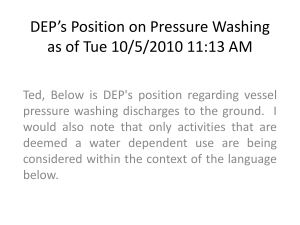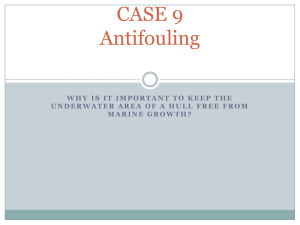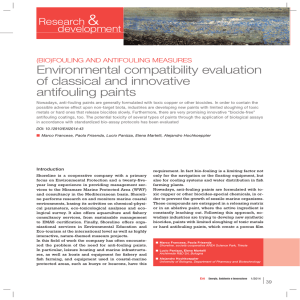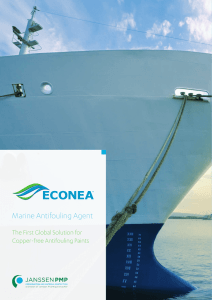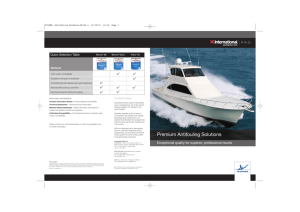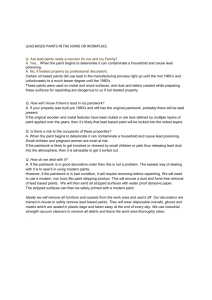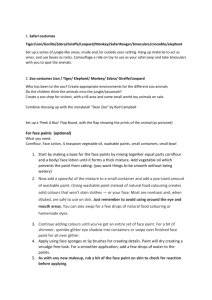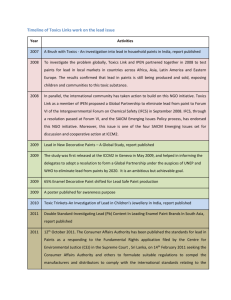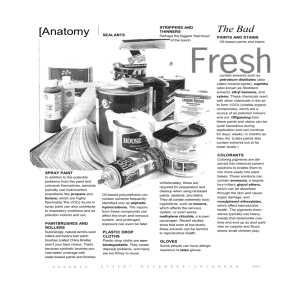Antifouling paint reassessment feedback form
advertisement
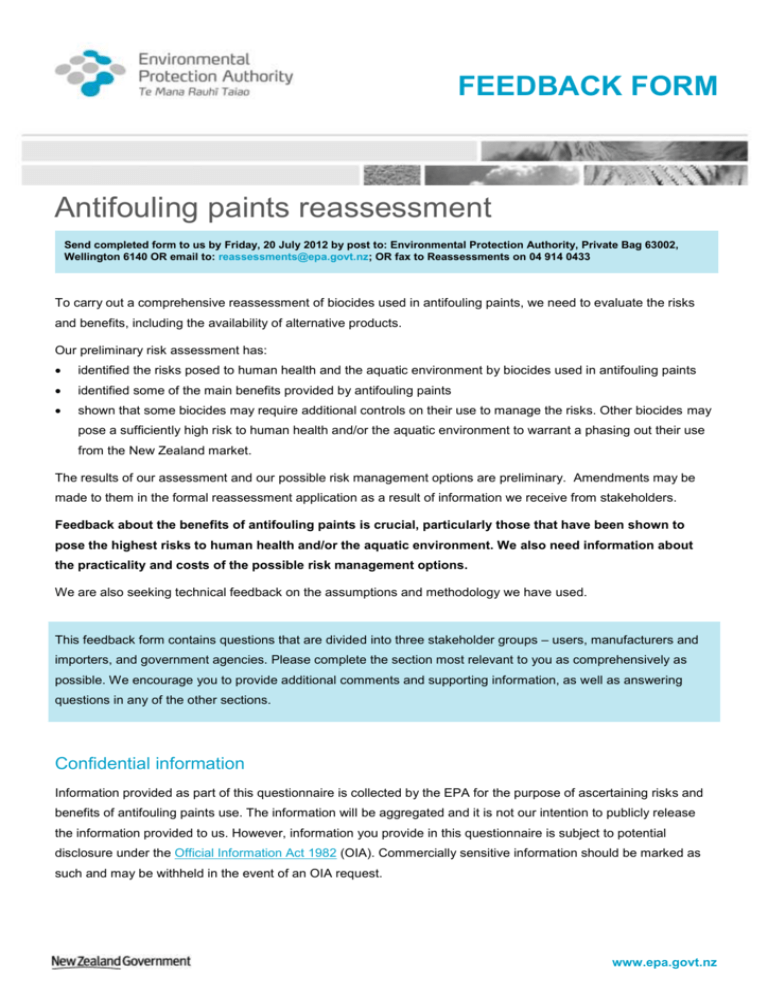
FEEDBACK FORM Antifouling paints reassessment Send completed form to us by Friday, 20 July 2012 by post to: Environmental Protection Authority, Private Bag 63002, Wellington 6140 OR email to: reassessments@epa.govt.nz; OR fax to Reassessments on 04 914 0433 To carry out a comprehensive reassessment of biocides used in antifouling paints, we need to evaluate the risks and benefits, including the availability of alternative products. Our preliminary risk assessment has: identified the risks posed to human health and the aquatic environment by biocides used in antifouling paints identified some of the main benefits provided by antifouling paints shown that some biocides may require additional controls on their use to manage the risks. Other biocides may pose a sufficiently high risk to human health and/or the aquatic environment to warrant a phasing out their use from the New Zealand market. The results of our assessment and our possible risk management options are preliminary. Amendments may be made to them in the formal reassessment application as a result of information we receive from stakeholders. Feedback about the benefits of antifouling paints is crucial, particularly those that have been shown to pose the highest risks to human health and/or the aquatic environment. We also need information about the practicality and costs of the possible risk management options. We are also seeking technical feedback on the assumptions and methodology we have used. This feedback form contains questions that are divided into three stakeholder groups – users, manufacturers and importers, and government agencies. Please complete the section most relevant to you as comprehensively as possible. We encourage you to provide additional comments and supporting information, as well as answering questions in any of the other sections. Confidential information Information provided as part of this questionnaire is collected by the EPA for the purpose of ascertaining risks and benefits of antifouling paints use. The information will be aggregated and it is not our intention to publicly release the information provided to us. However, information you provide in this questionnaire is subject to potential disclosure under the Official Information Act 1982 (OIA). Commercially sensitive information should be marked as such and may be withheld in the event of an OIA request. www.epa.govt.nz 2 Antifouling paints reassessment Feedback Form The EPA may withhold information under the OIA if there is “good reason” to withhold it, such as commercial sensitivity, privacy or protection of trade secrets, provided that the withholding of the information is not outweighed by other considerations which render it desirable, in the public interest, to make the information available. Grounds that are considered a “good reason” to withhold information can be found in sections 6, 9 and 18 of the OIA. To answer these questions fully, you will need to refer to the Call for Information document and the Preliminary Risk Assessment document that can be downloaded from our website at: http://www.epa.govt.nz/publications-resources/topics/Pages/Antifouling-paints.aspx. You can complete this feedback form by downloading it to your PC, typing your responses directly into it and attaching it to an email. Or, you can print it and post or fax it to us. Please insert additional pages where necessary. You can email us at reassessments@epa.govt.nz or call Jo on 04 918 4822 if you have any questions or need further information. June 2012 3 Antifouling paints reassessment Feedback Form Stakeholder group 1: Boat owners, marina operators, professional applicators and other users 1. Please identify which antifouling paints from Table 1 (refer to Call for Information document, pages 5-6) you use and why you use them. Product trade name Reason for use 2. The main benefits of preventing biofouling are listed on page 14 of the Call for Information document are common to all antifouling paints. What other specific benefits do you receive from the active ingredient/ antifouling paint that you use? Active ingredient/antifouling paint Benefit 3. For each possible risk management option listed in Table 3 (Call for Information document, page 13) please tell us what impact they would have on your use of antifouling paints e.g. are they practical, feasible, enforceable? Will they lead to an increase/decrease in your costs? Proposed risk management option Impact 4. If you use antifouling paints that contain any of the biocides chlorothalonil, diuron, Irgarol or ziram, (Call for Information document, page 11), and a phase out is indicated, what alternative products would you use and why? Alternative product Reason 5. For the products you have listed in question 4 above, how effective are they compared to the antifouling paints that you currently use? Consider differences in cost, efficacy, application etc. Product June 2012 Effectiveness of alternative 4 Antifouling paints reassessment Feedback Form Stakeholder group 2: Importers and manufacturers 6. Please identify which of the antifouling paints listed in Table 1 (Call for Information document, pages 5-6) you import/manufacture, and explain what commercial benefits they provide to you and what efficacy benefits they provide to your customers. Product trade name Benefits to you Benefits to customers 7. If the biocides chlorothalonil, diuron, Irgarol and ziram were no longer available for use in antifouling paints, what would the impact on your business be? Area of business Impact on business 8. What product/s would you market to replace those containing any of the biocides mentioned in question 7 above? What would be the overall difference in cost to your business to do this? How long would it take to implement this change? Current biocide/paint Replacement biocide/paint Cost difference Implementation chlorothalonil diuron ziram Irgarol 9. Please provide detailed information about how each possible risk management option in Table 3 (Call for Information document, page 13) would impact your business. Consider their effectiveness, practicality, enforceability and any compliance costs you would incur. Control Impact 10. If you have any further comments about any aspect of our risk assessment and possible risk management options that are not covered by these questions, please provide them below (refer to both the Call for Information and Preliminary Risk Assessment documents). June 2012 5 Antifouling paints reassessment Feedback Form Stakeholder group 3: Government agencies 11. Would any of the possible risk management options listed in Table 3 (Call for Information document, page 13) create regulatory duplications with controls already covered by other agencies/legislation? Please provide details. 12. Do you think the possible risk management options are practical and enforceable? Please provide evidence to support your response. 13. Would any of the possible risk management options create any additional costs for government agencies to ensure compliance? Please specify what the costs would be and who they would affect. 14. Please provide further comments about any aspect of our risk assessment and possible risk management options that are not covered by your responses to the questions above. Technical feedback We are also seeking technical feedback on the scenario assumptions, risk assessment methodology and data gaps in our risk assessments. Importers and manufacturers 15. Our risk assessment has based some assumptions solely on dermal absorption values for the individual biocide, not the formulated paint (Preliminary Risk Assessment document, Sections 2.4 and 3.1.8). Please provide any information/results you have about dermal absorption values for the paints you manufacture/import. Formulated paint Dermal absorption results 16. To calculate the risks posed to human health, we used specific concentrations of each biocide in each formulated paint (Preliminary Risk Assessment document, Section 3.1). Do you agree/disagree with the concentrations? Please provide information to support your comment. June 2012 6 Antifouling paints reassessment Feedback Form 17. To accurately predict the concentrations of biocides in the environment, we need realistic information about the market share values for all antifouling paints you manufacture/import. Where possible, please provide this information. Users 18. We have assumed that when antifouling paints are applied by spraying, there are two tasks performed by two different operators involved in the process: Mixing and loading performed by an ancillary operator, and spraying by another operator (Preliminary Risk Assessment document, Section 2.1). Is this assumption correct for New Zealand conditions? If not, please provide more details regarding this type of paint application, explaining in detail the roles of the operator(s). 19. We have assumed that a user is exposed to antifouling paint for the following durations during different stages of the application process (Preliminary Risk Assessment document, Section 2.4): 180 minutes/day for brush and roller, and mixing/loading activities 300 minutes/day for high-pressure spraying Do these exposure times accurately reflect your use? If not, please provide any additional information about how they differ. 20. Please provide any further comments about any technical aspect of our risk assessment that is not covered by your responses to the questions above or any further information that could help us refine our risk assessment. Contact details We may need to get in touch with you to talk about your feedback. Please provide your contact details below. Name: Stakeholder Group: Organisation: Position held (where application): Email: Phone no: June 2012
